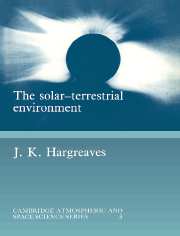 The Solar-Terrestrial Environment
The Solar-Terrestrial Environment Book contents
- Frontmatter
- Contents
- Preface
- 1 The Earth in space
- 2 The physics of geospace
- 3 Techniques for observing geospace
- 4 The neutral atmosphere
- 5 The solar wind and the magnetosphere
- 6 Principles of the ionosphere at middle and low latitudes
- 7 Ionospheric phenomena at middle and low latitudes
- 8 The ionosphere at high latitude
- 9 Magnetospheric waves
- 10 Technological application of geospace science
- Index
7 - Ionospheric phenomena at middle and low latitudes
Published online by Cambridge University Press: 29 January 2010
- Frontmatter
- Contents
- Preface
- 1 The Earth in space
- 2 The physics of geospace
- 3 Techniques for observing geospace
- 4 The neutral atmosphere
- 5 The solar wind and the magnetosphere
- 6 Principles of the ionosphere at middle and low latitudes
- 7 Ionospheric phenomena at middle and low latitudes
- 8 The ionosphere at high latitude
- 9 Magnetospheric waves
- 10 Technological application of geospace science
- Index
Summary
There is no excellent beauty that hath not some strangeness in the proportion.
Francis Bacon (1561–1626), Essay 43, Of BeautyThe geospace environment is complex and subtle. The concepts of the previous chapter lay down the basis of ionospheric behaviour, but in the real world additional factors conspire to complicate matters. To a large extent the ionosphere varies in a regular and predictable manner, but these regularities may not always accord with simple theory. In addition, major perturbations called storms occur from time to time, and the spatial structure includes irregularities of various sizes. Indeed, it appears that the structure of the ionosphere includes all the scales of space and time that are accessible to observation.
In this chapter we will first consider the regular behaviour of the ionosphere at middle and low latitudes, including ionospheric electric currents, and will then discuss perturbations and irregularities.
Observed behaviour of the mid-latitude ionosphere
We will begin with the regularities of the ionosphere – those variations with altitude, time of day, latitude, season, and solar cycle which are repeatable and therefore predictable (at least to an extent), and also with the ionosphere's response to solar flares and eclipses. All of these relate to the larger scales of variation: vertical distances measured in tens and hundreds of kilometres, horizontal distances in hundreds and thousands of kilometres, times in hours to years.
It should not be assumed, though, that because behaviour is regular it is necessarily understood. Historically, ionospheric observations were compared with the Chapman theory of the production of an ionospheric layer (Sections 6.2.2 and 6.2.4), and major departures from the theory were christened ‘anomalies’.
- Type
- Chapter
- Information
- The Solar-Terrestrial EnvironmentAn Introduction to Geospace - the Science of the Terrestrial Upper Atmosphere, Ionosphere, and Magnetosphere, pp. 249 - 311Publisher: Cambridge University PressPrint publication year: 1992


